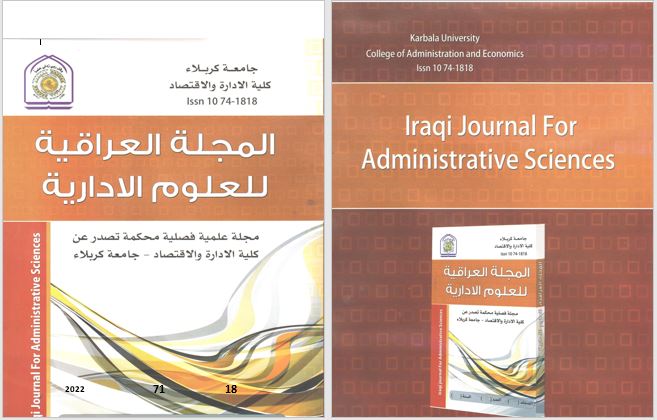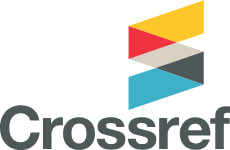The effect of the determinants of the financing structure on financial leverage
Applied study of a sample of companies listed in the Iraq Stock Exchange).
Keywords:
company size, company age, , tangibility, profitability, , liquidity, growth opportunities, tax exemption, financial leverageAbstract
The research seeks to test the impact and contribution of the determinants of the financing structure represented by (company size, age, tangibility of assets, profitability, liquidity, growth opportunities and tax shield) in the financial leverage of a sample of Iraqi industrial companies listed on the Iraq Stock Exchange (ISX).
The problem of the study was represented in the difficulties facing Iraqi companies in exploiting the determinants of the financing structure to reduce financing costs by determining the appropriate financial leverage and choosing the appropriate financing mixture. The research was conducted in the industrial sector of the above market out of a total of 25 representing the research community, while the sample consists of 5 companies, over a 14-year period extending from 2005 to 2018.
The researchers used well-known financial methods to extract the value of the company's size and life, in addition to the tangibility of assets and opportunities for growth, as well as the rate of return on assets, the ratio of trading and tax exemption, and finally the researchers used the financial leverage represented by the ratio of liabilities to assets.
The researchers relied for the purpose of testing the effect of the independent variables on the dependent variable on multiple regression. The results showed that the determinants of the financing structure for all companies had a significant effect on the financial leverage.
References
- Abdul, A. A. A. (2017). The Relationship between Solvency Ratios and Profitability Ratios: Analytical Study in Food Industrial Companies listed in Amman Bursa. International Journal of Economics and Financial Issues, 7(2), 86-93.
- Acedo-Ramirez, M. A., Ayala-Calvo, J. C., & Navarrete-Martinez, E. (2017). Determinants of Capital Structure: Family Businesses versus Non-Family Firms. Finance a Uver: Czech Journal of Economics & Finance, 67(2), 80-103.
- Akgül, E. F., & SİGALI, S. (2018). Determinants of Capital Structure: An Application on BIST Transportation Index. Journal of Accounting & Finance, (77), 193-215.
- Anton, S. G., & Afloarei Nucu, A. E. (2019). Firm value and corporate cash holdings. Empirical evidence from the polish listed firms, 22(3), 121-134.
- Boshoff-Knoetze, A., & Steenkamp, L. P. (2019). Quantifying the interest tax shield for different investors in South Africa. African Journal of Business and Economic Research, 14(2), 25-45.
- Bundala, N. N. H. (2012). Do Tanzanian companies practice pecking order theory, agency cost theory or trade-off theory? An empirical study in Tanzania listed companies. International Journal of Economics and Financial Issues, 2(4), 401-422.
- Chaidir, C., & Pitriana, M. (2017). Faktor-faktor pengaruh return on investment. JIMFE (Jurnal Ilmiah Manajemen Fakultas Ekonomi), 3(2), 60-69.
- Chakrabarti, A., & Chakrabarti, A. (2019). The capital structure puzzle–evidence from Indian energy sector. International Journal of Energy Sector Management. 13(1), 2-23.
- Chipeta, C., & Deressa, C. (2016). Firm and country specific determinants of capital structure in Sub Saharan Africa. International Journal of Emerging Markets. Bradford 11(4), 649-673.
- Deng ,D., & Shao , R.(2020). Income Tax and Capital Structure of Multinational Corporations. Advances in Economics, Business and Management Research, (133),20-24.
- Dewi, A. P., Sutrisno, S. T., & Purwanti, L. (2020). The impact of leverage on the earning response coefficients. International Journal of Research in Business and Social Science (2147-4478), 9(4), 277-285.
- El-Masry, A. A. (2016). Capital structure and performance of Middle East and North Africa (MENA) banks: an assessment of credit rating. Banks & bank systems, 11(1), 77-91.
- Fischer, M., & Jensen, B. A. (2019). The debt tax shield in general equilibrium. Journal of Banking & Finance, 100, 151-166.
- Gharaibeh, O. K., & Saqer, A. T. (2020). Determinants of capital structure: evidence from Jordanian service companies. Investment Management & Financial Innovations, 17(2), 364.
- Gharaibeh, O. K., & Saqer, A. T. (2020). Determinants of capital structure: evidence from Jordanian service companies. Investment Management & Financial Innovations, 17(2), 364-376.
- Gunarathna, V. (2016). How does financial leverage affect financial risk? An empirical study in Sri Lanka. Amity Journal of Finance, 1(1), 57-66.
- Hamilah, H. (2020). The Effect of Commissioners, Profitability, Leverage, and Size of the Company to Submission Timeliness of the Financial Statements Tax Avoidance as an Intervening Variable. Systematic Reviews in Pharmacy, 11(1), 349-357.
- Harjoto, M. A. (2017). Corporate social responsibility and degrees of operating and financial leverage. Review of Quantitative Finance and Accounting, 49(2), 487-513.
- Hedau, A., Singh, S., & Janor, H. (2018). Determinants Of Capital Structure–A Sector Specific Approach. Romanian Economic and Business Review, 13(4), 14-30.
- Hidayat, W., Tjaraka, H., Fitrisia, D., Fayanni, Y., Utari, W., Indrawati, M., ... & Samsi, N. (2020). The Effect of Earning per Share, Debt to Equity Ratio and Return on Assets on Stock Prices: Case Study Indonesian. Academy of Entrepreneurship Journal, 26(2), 1-10.
- Hundal, S., Sandstrom, A., & Uskumbayeva, A. (2018). The impact of the financial crisis on corporate capital structure dynamics in the nordic countries, Eurasian Journal of Economics and Finance; Istanbul 6(3), 34-51
- Husna, A., & Satria, I. (2019). Effects of Return on Asset, Debt to Asset Ratio, Current Ratio, Firm Size, and Dividend Payout Ratio on Firm Value. International Journal of Economics and Financial Issues, 9(5), 50-54.
- Iqbal, F., Ahmad, M. B., & Ali, H. F. (2019). Determinants of capital structure: an empirical study of KSE listed MNCs in Pakistan. Journal of Accounting, Finance and Auditing Studies 5(1), 173-195
- Khan, T. F., & Ghayas, A. (2020). A Study on the Determinants of Capital Structure: Evidence from India. IUP Journal of Applied Finance, 26(3), 47-59.
- Kizildag, M. (2015). Financial leverage phenomenon in hospitality industry sub-sector portfolios. International Journal of Contemporary Hospitality Management, 27(8), 1949-1978.
- Kliestik, T., Michalkova, L., & Kovacova, M. (2018). Is a tax shield really a function of net income, interest rate, debt and tax rate? Evidence from Slovak companies. Journal of International Studies, 11(4) ,295-311.
- Kolsi, M. C. (2017). The determinants of corporate voluntary disclosure policy. Journal of Accounting in Emerging Economies, 7(2), 249-265.
- Kozubíková, L., Vojtovič, S., Rahman, A., & Smrčka, L. (2016). The role of entrepreneur´ s gender, age and firm´ s age in autonomy. The case study from the Czech republic. Economics and Sociology, 9(2),168-182.
- Marie, L. I. G. O. C. K. Á. (2021). Relationship Between Profitability and Financial Leverage in Selected European Sugar Companies. Listy Cukrovarnické a Reparské, 137(4), 160
- Mathad, M. H. C. (2020). 38. A study on impact of leverage on the profitability & risk of the indian steel industry. One Day Online International Conference Organised by IRBE Publications, Denver, USA. 4, Special Issue (1), 223-227.
- Mayuri, T., & Kengatharan, L. (2019). Determinants of Capital Structure: Evidence from Listed Manufacturing Companies in Sri Lanka. SCMS Journal of Indian Management, 16(1), 43-56.
- Nawazish, M., Rahat, B., & Reddy, K. (2016). Financial leverage and stock returns: evidence from an emerging economy. Economic research-Ekonomska istraživanja, 29(1), 85-100.
- Öhman, P., & Yazdanfar, D. (2017). Short-and long-term debt determinants in Swedish SMEs. Review of Accounting and Finance, 16(1), 106-124.
- Pasha, A., & Ramzan, M. (2019). Asymmetric impact of economic value-added dynamics on market value of stocks in Pakistan stock exchange, a new evidence from panel co-integration, FMOLS and DOLS. Cogent Business & Management, 6(1), 1-14.
- Pordea, D., David, D., & Mateș, D. (2020). The Impact of Operating Cash Flow and Current Ratio on the Profitability in Construction Industry. Studia Universitatis „Vasile Goldis” Arad–Economics Series, 30(1), 22-32.
- Scholz, A., Rochdi, K., & Schaefers, W. (2015). Does asset liquidity matter? Evidence from real estate stock markets. Journal of European Real Estate Research. 8(3), 220-242.
- Wahjudi, E. (2019). Factors affecting dividend policy in manufacturing companies in Indonesia Stock Exchange. Journal of Management Development ,39(1) ,4-17.
- Wasim, S. S., Alam, S., & Saeed, M. (2016). An Empirical Analysis of Capital Structure of KSE-100 Listed Electricity Companies of Pakistan. Global Management Journal for Academic & Corporate Studies, 6(1), 101-114.
- Zhang, X., & Zhou, H. (2020). Leverage structure and stock price synchronicity: Evidence from China. Plos one, 15(7), 1-15.
Conferences
- Šeligová, M. (2018). The impact of selected financial indicators related to the structure of funding sources on corporate liquidity in energy sector in the Czech republic and Slovak republic. Scientific papers of the University of Pardubice. Series D, Faculty of Economics and Administration. 42/2018.
Downloads
Published
How to Cite
Issue
Section
License
Copyright (c) 2024 Economics and Administration College - Karbala University

This work is licensed under a Creative Commons Attribution-NonCommercial-NoDerivatives 4.0 International License.
Authors retain the copyright of their papers without restrictions.










